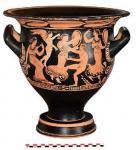Summary (English)
APOLLONIA (Krastina Panaiotova – kpanayotova@abv.bg, Margarit Damyanov) A building constructed in rubble masonry was explored. The finds included sherds, including from early sgraffito pottery of AD 1100 – 1150, the so-called Bulgarian sgraffito pottery of the end of the 11th – 12th centuries, Byzantine white earthenware of the Class IV according to Hayes dated to the 12th century and pottery from Syria. Part of the Via sacra was discovered in the necropolis. Family graveyards were documented on both sides of the road, surrounded with krepides and periboloi. Forty-six graves of the second half of the 5th – first half of the 3rd centuries BC were explored. Twenty-seven were burial pits, three graves were covered with roof-tiles (Grave No. 12 was a pit faced and covered with Corinthian tegulae, 11 with a stamp that reads: HM), ten graves were constructed of ashlars. In most cases the deceased were laid supine with heads to the east and in single cases they were laid in a Hocker position. Nine burials were cremations and eight of them were performed outside the graves. Thus, almost 20% of the dead discovered in this sector of the necropolis were cremated, while the average figure of the cremation burials in the necropolis of Apollonia is 10%. The cremated bones and the grave goods were placed in a pit, a stone urn, a ceramic urn, a red-figure krater, a red-figure hydria, a red-figure pelike and a pseudo-Cypriot amphora. The grave goods included red-figure lekythoi, lekythoi with polychrome and gilded decoration, black-gloss jugs, oinochoai, cups, pots, askoi, lekanai, ichthyai, terracotta grills for fish, amphorae, including from Mende, Chios and Thasos, terracotta figurines, a lead katadesmos, a lyre with a resonator made out of turtle shell placed in the grave of a girl dated to 425 – 400 BC, bronze strigils, mirrors, an iron pair of scissors and a small bronze knife placed in a wooden toilette box in Grave No. 17, bronze coins of Apollonia placed as Charon’s obols. A funerary stele with inscription that reads: ΠΑΡΜΕΝΩΝ ΣΚΥΡΩΝΟΣ, was discovered. Eighteen ritual hearths were explored, containing animal bones, carbonized remains from bread and mess, carbonized oak, wheat, einkorn, barley, lentils, chick-peas, vetch, peas, figs, grape, almonds, walnuts, hazelnuts, pistachios and pine nuts.
- Krastina Panaiotova - Archaeological Institute with Museum
- Margarit Damyanov - Archaeological Institute with Museum
Director
Team
Research Body
- Archaeological Institute with Museum






![Download [PDF]](/excavation/skins/fasti/images/results/download_sml.png)
